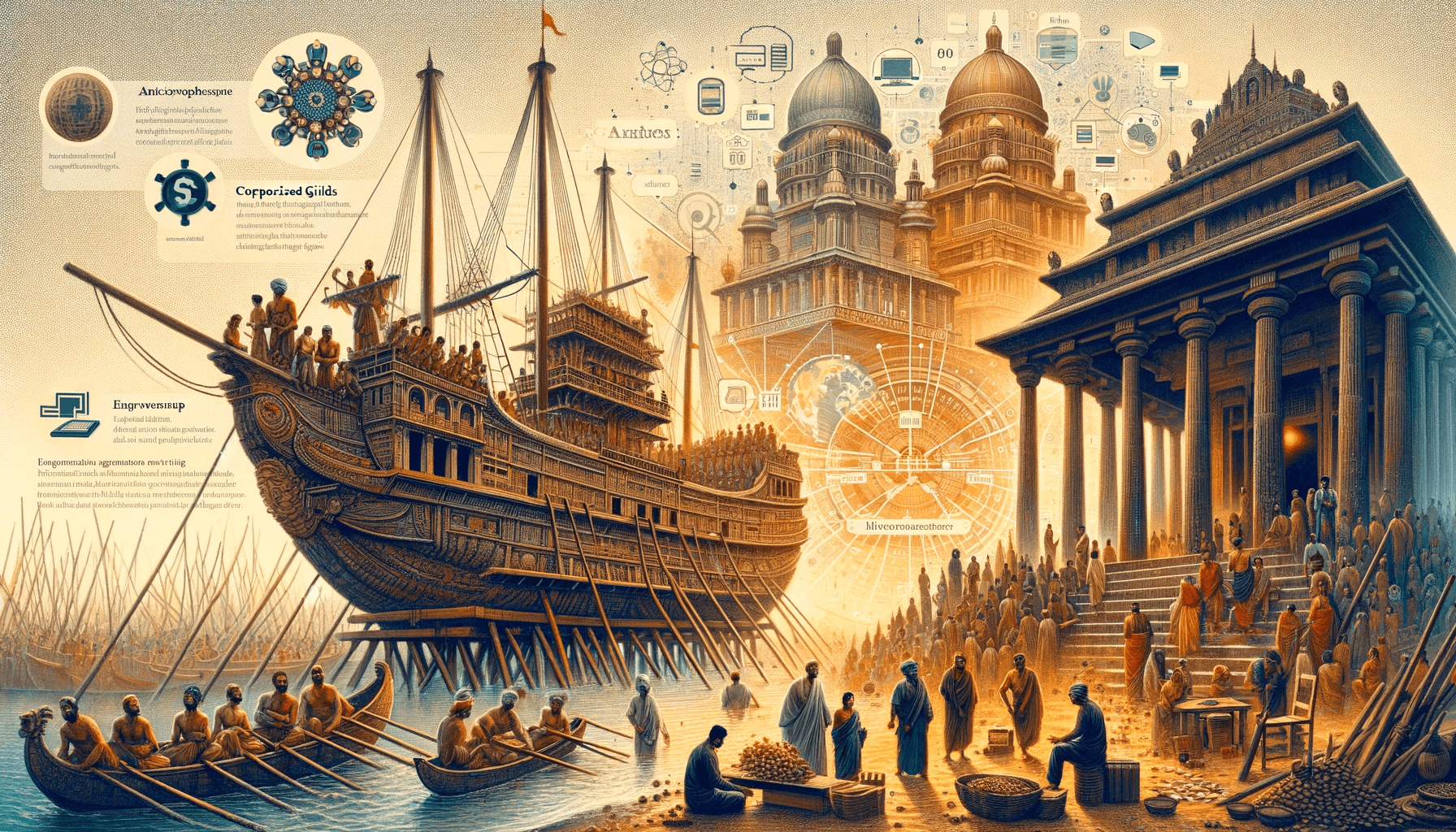The Cultural Legacy of Technology
The Cultural Legacy of Technology
From Ancient Shipbuilding to Modern Communication Tools
From Ancient Shipbuilding to Modern Communication Tools



Every great culture has its own way of doing things. The Polynesians, the Chinese, and the Europeans all mastered the art of shipbuilding, but each culture's design was a reflection of its unique worldview and way of life. The Polynesians, with their double-hulled canoes, skimmed across vast oceanic distances. The Chinese, with their junk rigs, dominated their waters with unmatched maneuverability. The Europeans, with their massive, square-rigged ships, imposed their will across the seas. Each of these vessels was more than just a means of transport; it was a cultural statement.
Fast forward to today. We no longer sail the seas to connect with one another. Instead, we navigate the vast digital ocean. And yet, the tools we use—Slack, Zoom, Microsoft Teams—each bear the cultural imprint of their creators. Just like those ancient ships, they are more than mere vessels; they shape how we communicate, collaborate, and even think. Let’s explore how this evolution has occurred and how the echoes of ancient design philosophies still resonate in our digital tools today.
The Polynesians: Wayfinding Through Intuition
Imagine a lone Polynesian navigator in the middle of the Pacific Ocean. No GPS, no compasses—just the stars, the sea, and the deep knowledge passed down through generations. Their double-hulled canoes were marvels of engineering, designed not for battle but for balance, speed, and endurance. They didn’t conquer the sea; they worked with it, reading its currents and respecting its moods. Their tools were an extension of their intuition—a marriage of the natural world and human understanding.
Now, consider the modern digital tools that embrace this ethos of intuitive navigation. Think of Slack, the chat platform that has become the virtual office for many startups and tech companies. It is not rigid; it flows. Channels can be created and abandoned in moments, adapting to the needs of the team. Conversations are fluid, and hierarchies are flattened. Slack doesn’t try to impose order; it invites you to find your own way, just like a Polynesian wayfinder. It’s a tool that respects the natural rhythms of communication, where serendipity and intuition often lead to the most valuable discoveries.
The Chinese: Stability and Adaptability

On the other side of the world, the Chinese junk rig was a different marvel. With its multiple masts and distinctive sails, the junk was a symbol of stability and adaptability. It could sail against the wind and was renowned for its ability to navigate both shallow and deep waters. The Chinese didn't just build ships; they built ships that could go anywhere. This versatility allowed them to maintain trade routes that were as vast as they were profitable.
In the digital age, Microsoft Teams embodies this spirit. It's not as fluid as Slack, but it is stable and comprehensive. With its tightly integrated suite of tools—everything from document collaboration to video conferencing—Microsoft Teams is like a junk ship that can navigate any business environment. It’s designed for those who need everything in one place, who value reliability over the unpredictable tides of creative chaos. It adapts to the wind, but it also charts a steady course.
The Europeans: Mastery Through Control

And then there were the Europeans. The Spanish galleons, the British frigates—these ships were built for conquest. They were big, formidable, and designed to carry vast amounts of cargo or to engage in naval warfare. They represented control, mastery, and a certain rigidity. These ships were the bulldozers of the sea, imposing their will wherever they went.
Today, this philosophy finds its modern-day counterpart in tools like Zoom. It’s direct, purpose-driven, and, some would argue, almost militaristic in its efficiency. Zoom does one thing exceptionally well—video conferencing. There’s no fluff, no unnecessary features cluttering the deck. Just straightforward communication. Like the European ships that sought to dominate the seas, Zoom seeks to dominate its niche. It’s all about the mission, and everything else is secondary.
Technology as a Mirror and a Mold
What does all this mean for us today? The tools we use are not just reflections of our cultures; they actively shape them. Polynesian canoes influenced how their people interacted with the sea, just as Slack influences how modern teams communicate—encouraging spontaneity, discovery, and a certain organic messiness. The Chinese junk’s adaptability mirrors Microsoft Teams' broad utility, promoting a more stable, integrated approach to work. The rigid, mission-focused European vessels find a modern expression in Zoom's singular purpose and directness.
But there’s another layer to consider: we choose these tools, but they also choose us. A company that thrives on creativity and spontaneity is drawn to Slack because it resonates with their culture, just as an empire of old would choose a ship that aligns with its own values. Conversely, using a tool long enough begins to shape the company’s culture in return. A team accustomed to the flexibility of Slack might struggle with the rigidity of Teams, just as a sailor used to navigating by the stars would find it jarring to be on a galleon.
Conclusion: Your Technology, Your Culture
As we chart the digital seas of the modern age, the tools we choose are not just instruments of convenience. They are cultural artifacts, each with its own legacy, philosophy, and impact. They don’t just serve us—they shape us. The lessons from Polynesian, Chinese, and European shipbuilders remind us that technology is never neutral. It always carries with it the ethos of its creators and molds the habits and values of its users.
So, when you next choose a tool for your team, ask yourself: What kind of culture are you building? Are you a wayfinder seeking fluidity and connection, a versatile trader navigating diverse needs, or a conqueror focused on mission and control? Remember, your tools are your ships, and every ship sets its own course. Choose wisely.
Every great culture has its own way of doing things. The Polynesians, the Chinese, and the Europeans all mastered the art of shipbuilding, but each culture's design was a reflection of its unique worldview and way of life. The Polynesians, with their double-hulled canoes, skimmed across vast oceanic distances. The Chinese, with their junk rigs, dominated their waters with unmatched maneuverability. The Europeans, with their massive, square-rigged ships, imposed their will across the seas. Each of these vessels was more than just a means of transport; it was a cultural statement.
Fast forward to today. We no longer sail the seas to connect with one another. Instead, we navigate the vast digital ocean. And yet, the tools we use—Slack, Zoom, Microsoft Teams—each bear the cultural imprint of their creators. Just like those ancient ships, they are more than mere vessels; they shape how we communicate, collaborate, and even think. Let’s explore how this evolution has occurred and how the echoes of ancient design philosophies still resonate in our digital tools today.
The Polynesians: Wayfinding Through Intuition
Imagine a lone Polynesian navigator in the middle of the Pacific Ocean. No GPS, no compasses—just the stars, the sea, and the deep knowledge passed down through generations. Their double-hulled canoes were marvels of engineering, designed not for battle but for balance, speed, and endurance. They didn’t conquer the sea; they worked with it, reading its currents and respecting its moods. Their tools were an extension of their intuition—a marriage of the natural world and human understanding.
Now, consider the modern digital tools that embrace this ethos of intuitive navigation. Think of Slack, the chat platform that has become the virtual office for many startups and tech companies. It is not rigid; it flows. Channels can be created and abandoned in moments, adapting to the needs of the team. Conversations are fluid, and hierarchies are flattened. Slack doesn’t try to impose order; it invites you to find your own way, just like a Polynesian wayfinder. It’s a tool that respects the natural rhythms of communication, where serendipity and intuition often lead to the most valuable discoveries.
The Chinese: Stability and Adaptability

On the other side of the world, the Chinese junk rig was a different marvel. With its multiple masts and distinctive sails, the junk was a symbol of stability and adaptability. It could sail against the wind and was renowned for its ability to navigate both shallow and deep waters. The Chinese didn't just build ships; they built ships that could go anywhere. This versatility allowed them to maintain trade routes that were as vast as they were profitable.
In the digital age, Microsoft Teams embodies this spirit. It's not as fluid as Slack, but it is stable and comprehensive. With its tightly integrated suite of tools—everything from document collaboration to video conferencing—Microsoft Teams is like a junk ship that can navigate any business environment. It’s designed for those who need everything in one place, who value reliability over the unpredictable tides of creative chaos. It adapts to the wind, but it also charts a steady course.
The Europeans: Mastery Through Control

And then there were the Europeans. The Spanish galleons, the British frigates—these ships were built for conquest. They were big, formidable, and designed to carry vast amounts of cargo or to engage in naval warfare. They represented control, mastery, and a certain rigidity. These ships were the bulldozers of the sea, imposing their will wherever they went.
Today, this philosophy finds its modern-day counterpart in tools like Zoom. It’s direct, purpose-driven, and, some would argue, almost militaristic in its efficiency. Zoom does one thing exceptionally well—video conferencing. There’s no fluff, no unnecessary features cluttering the deck. Just straightforward communication. Like the European ships that sought to dominate the seas, Zoom seeks to dominate its niche. It’s all about the mission, and everything else is secondary.
Technology as a Mirror and a Mold
What does all this mean for us today? The tools we use are not just reflections of our cultures; they actively shape them. Polynesian canoes influenced how their people interacted with the sea, just as Slack influences how modern teams communicate—encouraging spontaneity, discovery, and a certain organic messiness. The Chinese junk’s adaptability mirrors Microsoft Teams' broad utility, promoting a more stable, integrated approach to work. The rigid, mission-focused European vessels find a modern expression in Zoom's singular purpose and directness.
But there’s another layer to consider: we choose these tools, but they also choose us. A company that thrives on creativity and spontaneity is drawn to Slack because it resonates with their culture, just as an empire of old would choose a ship that aligns with its own values. Conversely, using a tool long enough begins to shape the company’s culture in return. A team accustomed to the flexibility of Slack might struggle with the rigidity of Teams, just as a sailor used to navigating by the stars would find it jarring to be on a galleon.
Conclusion: Your Technology, Your Culture
As we chart the digital seas of the modern age, the tools we choose are not just instruments of convenience. They are cultural artifacts, each with its own legacy, philosophy, and impact. They don’t just serve us—they shape us. The lessons from Polynesian, Chinese, and European shipbuilders remind us that technology is never neutral. It always carries with it the ethos of its creators and molds the habits and values of its users.
So, when you next choose a tool for your team, ask yourself: What kind of culture are you building? Are you a wayfinder seeking fluidity and connection, a versatile trader navigating diverse needs, or a conqueror focused on mission and control? Remember, your tools are your ships, and every ship sets its own course. Choose wisely.
Related Blogs


The Cultural Impact of NFTs
See how Ethiopian artist collective Yatreda uses NFTs to preserve culture and what businesses can learn from their blend of tradition and technology.


The History of Culturology
Culturology was coined by scholar Mikhail Petrovich Ryazanov, who emphasized the scientific study of culture as an independent and vital area of inquiry.


Introducing Business Culturology
A pioneering framework that brings clarity and actionability to the realm of organizational culture.